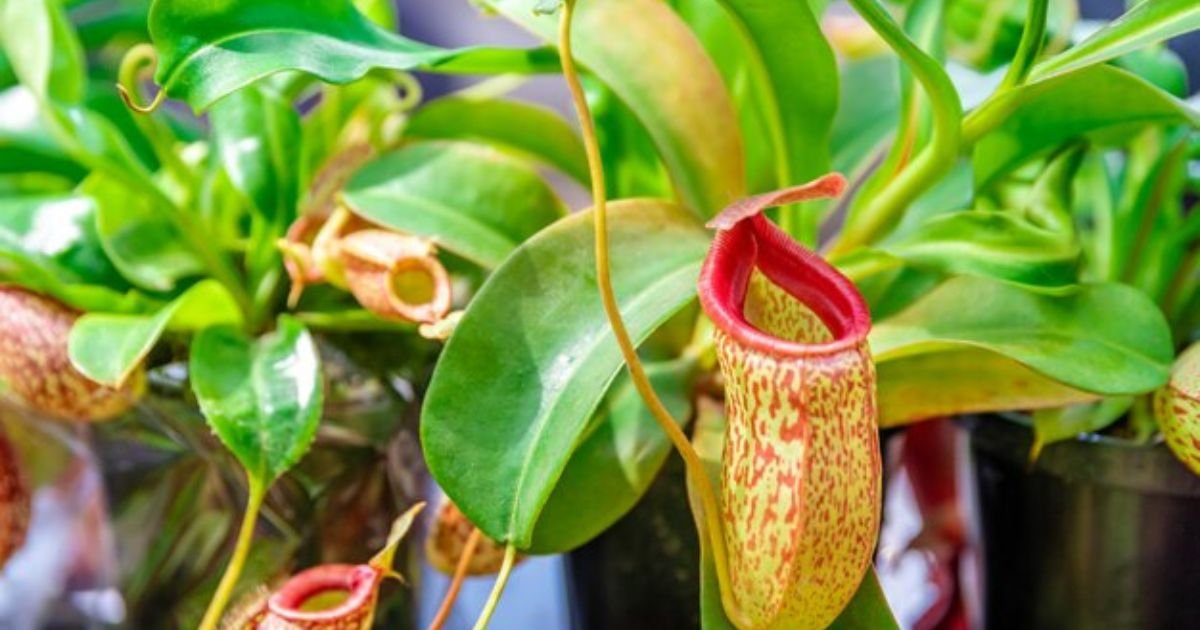Introduction to Tropical Pitcher Plants
Tropical pitcher plants, scientifically known as Nepenthes, are among nature’s most captivating and unusual plants. Unlike most plants that rely solely on photosynthesis to meet their nutritional needs, tropical pitcher plants supplement their diet by capturing and digesting insects. This carnivorous behavior helps them thrive in nutrient-poor environments, making them a unique subject of fascination for botanists and plant enthusiasts alike.
What Makes Pitcher Plants Carnivorous?
The hallmark feature of it is their specialized leaves, which have evolved into pitcher-shaped structures. These “pitchers” are designed to trap insects and other small creatures. The interior of the pitcher contains digestive fluids that break down prey, providing the plant with essential nutrients like nitrogen and phosphorus, which are often lacking in their natural habitats.
How Do Pitcher Plants Trap Their Prey?
The trapping mechanism of tropical pitcher plants is a blend of evolutionary brilliance and biological engineering. The upper rim of the pitcher, known as the peristome, is slippery, causing insects to lose their grip and fall into the trap. Once inside, the insects encounter digestive fluids, and escape becomes nearly impossible. The interior walls of the pitcher are smooth, offering no foothold for trapped prey to climb out.
Where Are Tropical Pitcher Plants Found?
it are native to Southeast Asia, especially in countries like Borneo, Sumatra, and the Philippines. These plants usually grow in humid, tropical environments such as rainforests, where the soil is often low in nutrients. By evolving a carnivorous nature, pitcher plants have carved out a niche in these challenging environments.
The Unique Anatomy of a Pitcher Plant
The anatomy of a tropical pitcher plant is fascinating. Its modified leaf structure forms the pitcher, which is often brightly colored to attract prey. Inside the pitcher, there are tiny downward-pointing hairs that prevent insects from escaping once they’ve fallen in. The plant also produces nectar around the peristome to lure unsuspecting insects. This evolutionary adaptation allows the plant to thrive in environments where other plants would struggle.
Tropical Pitcher Plant Species and Varieties
There are over 150 species of Nepenthes, with many varieties exhibiting different colors, sizes, and shapes. Some of the most well-known species include Nepenthes rajah, which can trap small mammals, and Nepenthes alata, a common species with slender, elegant pitchers. The diversity within the genus ensures that each species is adapted to its specific habitat, with variations in pitcher size and trapping mechanisms.
Growing Tropical Pitcher Plants at Home
For plant enthusiasts, tropical pitcher plants can be grown at home, though they require specific care. They thrive in humid environments with plenty of indirect sunlight. These plants do well in terrariums where humidity and temperature can be controlled. When grown indoors,it should be watered with distilled or rainwater, as they are sensitive to chemicals found in tap water.
Care and Maintenance of Tropical Pitcher Plants
Caring for it requires patience and attention to detail. Since they are native to nutrient-poor soils, they don’t require traditional fertilizers. Instead, they rely on the insects they trap for nourishment. It’s essential to keep the soil moist but not waterlogged, and the plant should never be allowed to dry out completely. Additionally, maintaining high humidity levels is key to keeping these plants healthy.
Pitcher Plants as Pest Control
One of the practical benefits of growing tropical pitcher plants is their ability to naturally control pests. By trapping and digesting flies, mosquitoes, and other insects, they reduce the number of unwanted bugs in your home or garden. This makes them not only a fascinating conversation piece but also an eco-friendly alternative to chemical pest control methods.
Conservation Status of Tropical Pitcher Plants
Many species of tropical pitcher plants are threatened or endangered due to habitat loss and overcollection. Deforestation and land development in tropical regions have significantly reduced their natural habitats. Some species, like Nepenthes clipeata, are critically endangered and require immediate conservation efforts. Botanical gardens and plant nurseries play a crucial role in preserving these species through cultivation and seed banking.
Threats to Their Natural Habitat
The main threat to tropical pitcher plants is deforestation. As rainforests are cleared for agriculture and urban development, these plants lose the unique environments they need to survive. Climate change also poses a significant risk by altering rainfall patterns and increasing temperatures, making it harder for these plants to thrive.
Pitcher Plants in Popular Culture
it plants have made their way into popular culture due to their unusual appearance and carnivorous nature. They’ve been featured in documentaries, television shows, and even video games. Their bizarre and seemingly alien qualities captivate the imagination, often symbolizing the mystery and danger of untamed nature.
Scientific Research on Pitcher Plants
they are the subject oextensive scientific research. Studies focus on their trapping mechanisms, the symbiotic relationships they form with certain insect species, and their evolutionary adaptations. Scientists are also interested in the potential for these plants to inspire biomimicry in engineering and technology, given their unique methods of trapping and digestion.
The Role of Pitcher Plants in Ecosystems
they a crucial role in their ecosystems. By trapping and consuming insects, they help regulate insect populations, which can affect other plants and animals in their habitat. Some species of insects have even evolved to live inside pitcher plants, creating a symbiotic relationship where both the plant and insect benefit.
Conclusion
Tropical pitcher plants are more than just botanical curiosities. They are a testament to the wonders of evolution, demonstrating how plants can adapt to even the most inhospitable environments. Whether admired for their beauty, their unusual behavior, or their role in ecosystems, it plants remain one of nature’s most extraordinary creations.
FAQs
Can tropical pitcher plants eat large prey?
Some species, like Nepenthes rajah, are capable of trapping small mammals, but most tropical pitcher plants primarily capture insects and small invertebrates.
How do I water tropical pitcher plants?
Use distilled or rainwater, as tap water contains minerals that can harm the plant. Keep the soil moist but not soaked.
Can I grow tropical pitcher plants indoors?
Yes, they can be grown indoors, especially in terrariums where humidity and temperature can be controlled.
Are tropical pitcher plants endangered?
Many species are endangered due to habitat loss and overcollection. Conservation efforts are in place to protect them.
How long does it take for a pitcher plant to digest its prey?
It typically takes several days to a week for a it to fully digest an insect.











